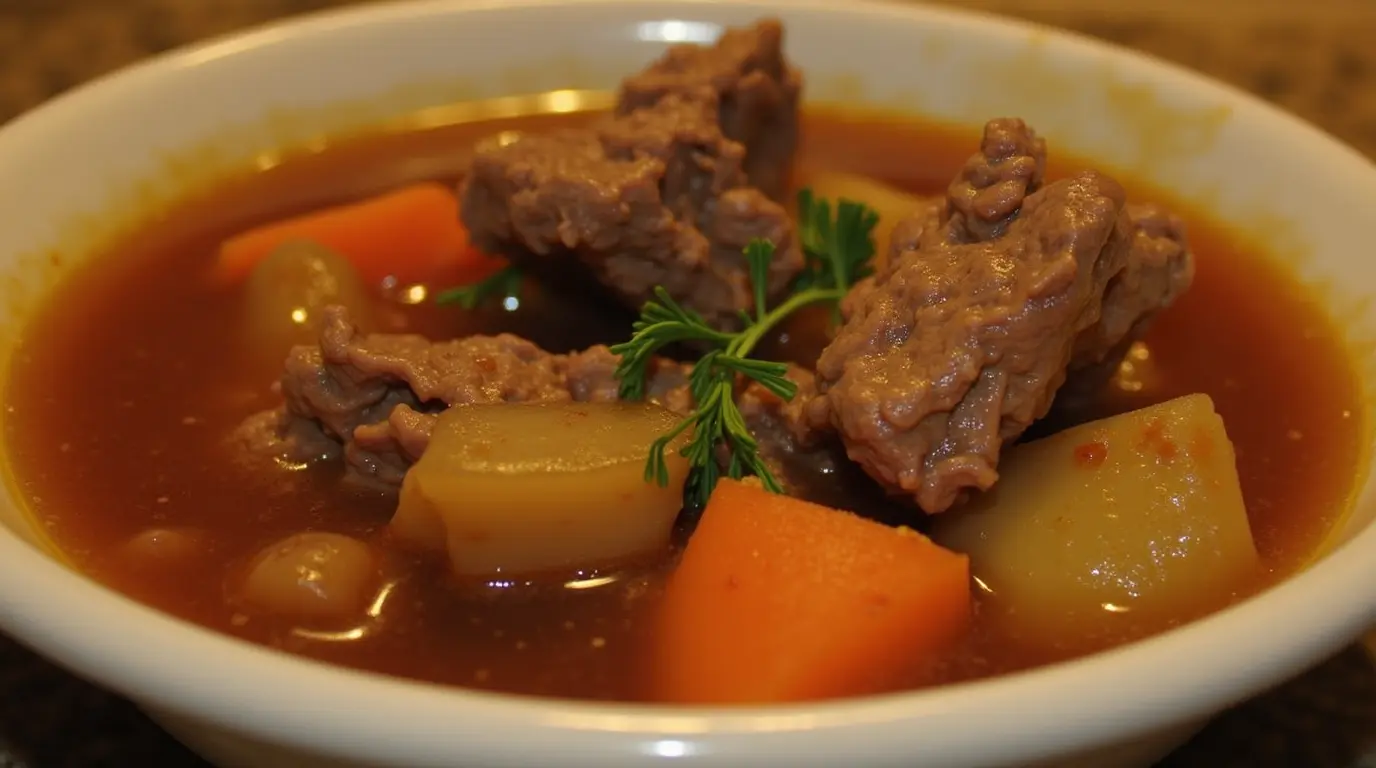Want that rich, slow-simmered flavor that makes any dish taste homemade?
Beef stock is the secret weapon. Whether you’re making it from scratch or using leftovers, these recipes show how to build depth, body, and bold taste in every spoonful. Time to turn scraps into liquid gold.
Table of contents
What is Beef Stock?
Definition of Beef Stock
Beef stock is a flavorful liquid made by simmering beef bones, often along with vegetables like onions, carrots, and celery, in water for several hours. The slow cooking process extracts collagen and gelatin from the bones, which gives the stock its rich texture. Unlike beef broth, which is typically made from meat and bones, stock relies heavily on the bones for its depth of flavor and body.
How Beef Stock is Made
Making beef stock at home is a simple process but requires patience. The basic steps involve roasting the bones to bring out their flavors, then simmering them for several hours to extract all the goodness.
- Roast the Bones: Beef bones are first roasted in the oven to caramelize and intensify their flavor.
- Simmer the Bones: The roasted bones are then simmered in a pot of water, often with added vegetables like carrots, celery, and onions, along with herbs such as thyme, rosemary, and bay leaves.
- Strain the Stock: After hours of simmering, the stock is strained to remove the bones and vegetable remnants, leaving a clear, rich liquid.
Why Use Beef Stock in Recipes?
Enhancing Flavor
Beef stock is a secret weapon for adding unparalleled depth and richness to your cooking. Its complex flavor, derived from simmering bones, vegetables, and herbs, acts as a foundation for countless dishes. When used in recipes, beef stock creates a savory backbone that complements other ingredients, making soups heartier, stews more robust, and sauces velvety and flavorful.
Health Benefits of Beef Stock
Beyond its culinary advantages, beef stock offers a host of health benefits. It is packed with essential nutrients like collagen, amino acids, and minerals, which can support joint health, skin elasticity, and overall wellness. The gelatin extracted from beef bones during the simmering process aids digestion and can soothe the gut lining, making it a valuable addition to a healthy diet.
Top Beef Recipes with Beef Stock
1. Classic Beef Stew with Beef Stock
Ingredients
- 2 lbs beef chuck, cut into 1-inch cubes
- 3 cups beef stock
- 2 tbsp olive oil
- 1 large onion, diced
- 3 carrots, sliced
- 3 potatoes, cubed
- 2 celery stalks, chopped
- 2 tbsp tomato paste
- 3 cloves garlic, minced
- 1 tsp dried thyme
- 1 tsp dried rosemary
- Salt and pepper to taste
- 2 tbsp all-purpose flour
- 1 cup red wine (optional)
- Fresh parsley for garnish

Directions
- Prepare the Beef: Season the beef cubes with salt and pepper. Heat olive oil in a large pot over medium-high heat and brown the beef on all sides. Remove and set aside.
- Sauté the Vegetables: In the same pot, add onion, carrots, celery, and garlic. Cook until softened, about 5 minutes.
- Build the Base: Stir in tomato paste and flour, cooking for 2 minutes. Deglaze the pot with red wine if using, scraping up browned bits from the bottom.
- Simmer the Stew: Return the beef to the pot. Add potatoes, thyme, rosemary, and beef stock. Bring to a boil, then reduce the heat to low and simmer for 2 hours, stirring occasionally.
- Final Touches: Adjust seasoning with salt and pepper. Serve hot, garnished with fresh parsley.
Cooking Tips
- For extra depth, roast the beef cubes before simmering.
- Add mushrooms or parsnips for additional texture and flavor.
2. Beef and Vegetable Soup with Beef Stock
Ingredients
- 1 lb ground beef
- 4 cups beef stock
- 1 onion, chopped
- 2 carrots, diced
- 1 zucchini, sliced
- 1 cup green beans, chopped
- 1 can diced tomatoes (14 oz)
- 1 tsp smoked paprika
- 1 tsp Italian seasoning
- Salt and pepper to taste
- 1 tbsp olive oil
- 1 cup small pasta (optional)
Directions
- Cook the Beef: Heat olive oil in a large pot over medium heat. Add ground beef and cook until browned. Remove excess fat.
- Sauté the Vegetables: Add onion, carrots, and green beans to the pot. Cook for 5 minutes until slightly softened.
- Combine Ingredients: Stir in diced tomatoes, beef stock, smoked paprika, and Italian seasoning. Bring to a boil.
- Simmer the Soup: Lower the heat and simmer for 20 minutes. Add zucchini and pasta (if using) in the last 10 minutes of cooking.
- Season and Serve: Adjust seasoning with salt and pepper. Serve hot with crusty bread.
Variations
- Replace ground beef with shredded beef for a heartier version.
- Use barley or rice instead of pasta for a gluten-free option.
Not sure how long beef stock lasts? Learn how to freeze beef stock properly and preserve its flavor for months.
3. Braised Beef Short Ribs in Beef Stock
Ingredients
- 4 lbs beef short ribs
- 3 cups beef stock
- 1 large onion, sliced
- 3 carrots, chopped
- 2 celery stalks, chopped
- 2 tbsp tomato paste
- 1 cup red wine (optional)
- 3 cloves garlic, minced
- 2 sprigs fresh thyme
- 1 sprig fresh rosemary
- 2 tbsp olive oil
- Salt and pepper to taste
Directions
- Prepare the Beef Ribs: Season the short ribs generously with salt and pepper. Heat olive oil in a large, heavy-bottomed pot or Dutch oven over medium-high heat. Sear the ribs until browned on all sides. Remove and set aside.
- Sauté the Vegetables: In the same pot, add onions, carrots, and celery. Cook for 5 minutes until softened. Stir in garlic and tomato paste, cooking for an additional 2 minutes.
- Deglaze the Pot: Add red wine (if using) to the pot, scraping up any browned bits from the bottom. Simmer for 2–3 minutes until the wine is slightly reduced.
- Braise the Ribs: Return the short ribs to the pot. Add beef stock, thyme, and rosemary. The liquid should cover about two-thirds of the ribs. Bring to a gentle simmer.
- Cook Low and Slow: Cover the pot and transfer it to a preheated oven at 325°F (160°C). Cook for 2.5–3 hours, or until the meat is tender and falling off the bone.
- Serve: Remove the ribs and strain the sauce, discarding the solids. Serve the ribs with the reduced sauce poured over the top.
Serving Suggestions
- Pair with creamy mashed potatoes or polenta for a complete meal.
- Garnish with fresh parsley or chives for added color and freshness.
If you’re interested in making a rich, nutrient-dense broth, check out this Chicken Bone Broth recipe for a flavorful and healthy alternative
How to Make Homemade Beef Stock
Ingredients Needed for Beef Stock
- 3–4 lbs beef bones (marrow, knuckles, or joint bones work best)
- 2 large onions, quartered
- 3 carrots, chopped
- 3 celery stalks, chopped
- 3 cloves garlic, peeled
- 2 bay leaves
- 5–6 sprigs fresh thyme
- 1 sprig fresh rosemary
- 10–12 cups water (enough to cover the bones)
- 1 tbsp apple cider vinegar (optional, helps extract nutrients from the bones)
- Salt and pepper to taste (optional, add later when using the stock)
Step-by-Step Instructions
- Roast the Bones
- Preheat the oven to 400°F (200°C). Spread the beef bones on a baking sheet in a single layer.
- Roast for 30–40 minutes, turning once, until the bones are deeply browned. This step enhances the flavor of the stock.
- Prepare the Stockpot
- Transfer the roasted bones to a large stockpot or slow cooker. Add onions, carrots, celery, garlic, bay leaves, thyme, and rosemary.
- Add Water and Simmer
- Pour enough water into the pot to fully cover the ingredients. Add apple cider vinegar (if using) to help extract nutrients from the bones.
- Bring the mixture to a boil over medium heat. Reduce to a low simmer and skim off any foam or impurities that rise to the surface.
- Cook Slowly
- Simmer gently for 8–12 hours. For a richer flavor, simmer up to 24 hours, adding more water if necessary to keep the bones submerged.
- Strain the Stock
- Once finished, strain the stock through a fine-mesh sieve or cheesecloth into a clean container, discarding the solids. Allow the stock to cool.
- Remove the Fat
- Refrigerate the stock overnight. Once chilled, skim off the solidified fat from the surface.
- Store and Use
- Divide the stock into portions and store in airtight containers. Refrigerate for up to 5 days or freeze for up to 6 months.
For a lighter alternative with similar health benefits, try our chicken bone broth recipe
Add a splash of beef stock to quick meals like this beef and broccoli stir-fry for added richness
Storage Tips for Beef Stock
- Freezing: Use ice cube trays to freeze small portions for easy use in recipes.
- Labeling: Always label containers with the date to keep track of freshness.
- Reheating: Bring frozen or refrigerated stock to a boil before using to ensure it’s safe to consume.
Frequently Asked Questions
What’s the difference between beef stock and beef broth?
Stock is made with bones and has a richer texture from the collagen. Broth uses mostly meat and has a lighter, thinner body.
Can I make beef stock in a slow cooker?
Absolutely. Just combine bones, veggies, and water — cook on low for 10–12 hours for deep flavor with no effort.
Should I roast the bones before making stock?
Yes. Roasting bones at 400°F for 30 minutes brings out richer color and deeper, caramelized flavor in your stock.
Can I freeze homemade beef stock?
Definitely. Freeze in containers or ice cube trays for up to 6 months. Always cool it first and label with the date.

